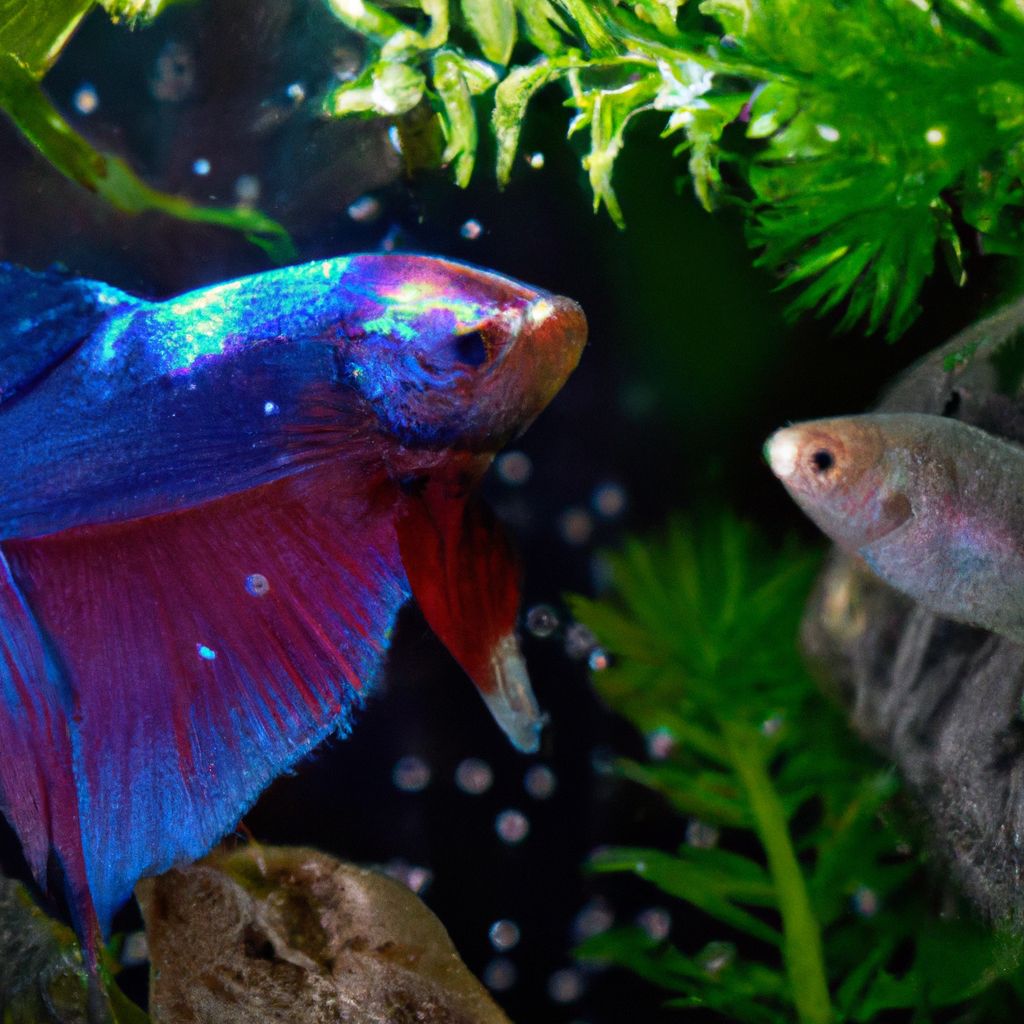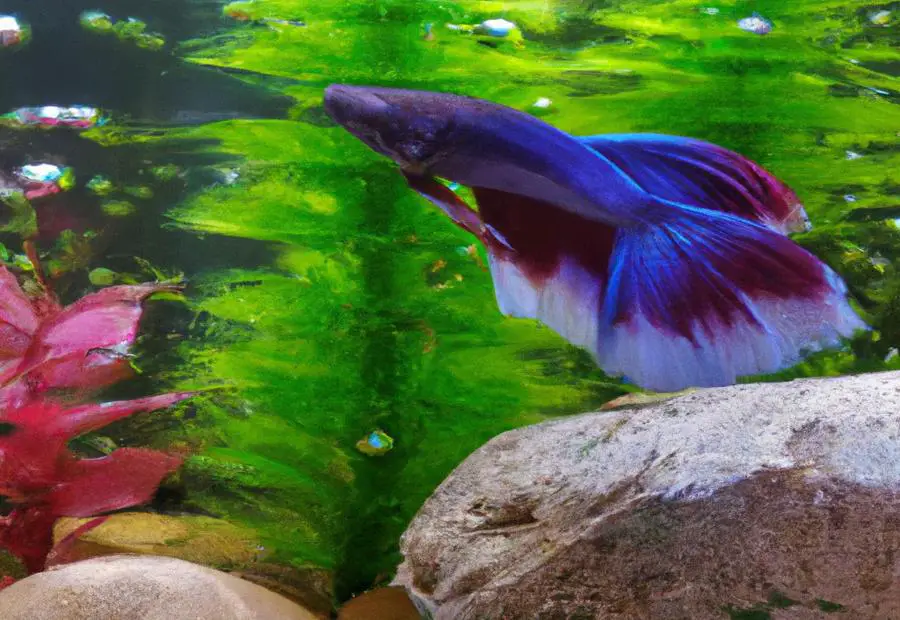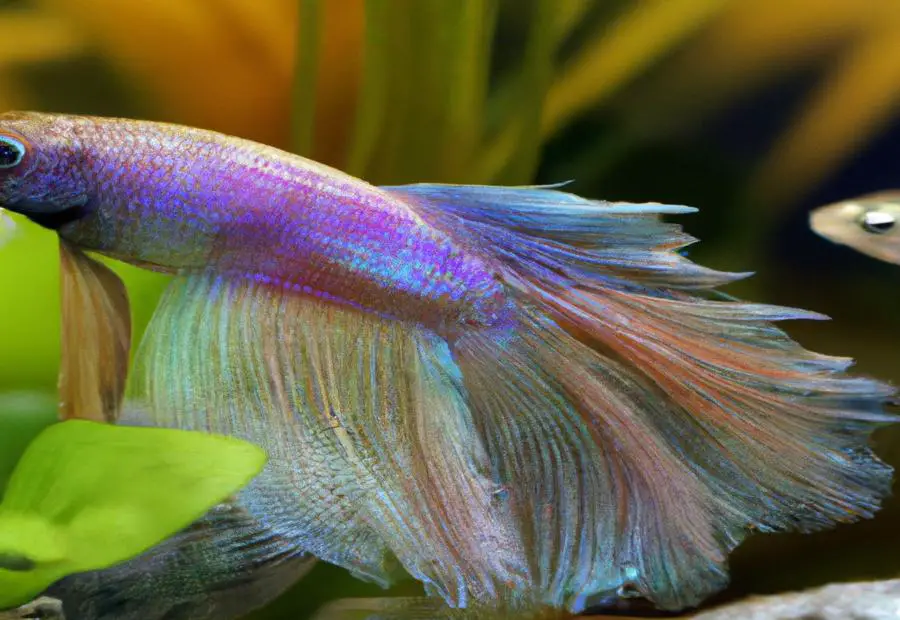Last Updated on 2 years by admin

Female betta fish and dwarf gourami are both popular choices for aquarium enthusiasts. However, it is crucial to understand the compatibility of these two species before considering housing them together. In this article, we will explore the dynamics between female betta fish and dwarf gourami and determine if they can coexist harmoniously in the same tank.
Before diving into compatibility, it is important to introduce each species individually. Female betta fish, also known as Siamese fighting fish, are known for their vibrant colors and graceful fins. Dwarf gourami, on the other hand, are small, peaceful labyrinth fish that come in various color variations. They both have unique characteristics and specific care requirements.
The main question we will address is whether female betta fish and dwarf gourami can live together peacefully. We will examine the compatibility factors that play a crucial role in determining if these two species can cohabitate successfully. we will look at the behavior and aggression levels exhibited by female bettas and dwarf gourami, and how to create an ideal tank environment for their coexistence.
By monitoring fish behavior and taking necessary precautions, it is possible to manage aggression and maintain a harmonious tank dynamic. We will discuss the importance of observing fish behavior and taking appropriate action to prevent aggression.
Key takeaway:
- Compatibility and considerations: Before housing female betta with dwarf gourami, it is important to consider their compatibility and various factors such as tank size, behavior, and aggression potential.
- Tank environment setup: Creating the right tank environment is crucial, including providing hiding spots, territories, and maintaining appropriate water parameters and filtration.
- Monitoring and managing: It is essential to observe fish behavior and take prompt action to prevent aggression between female betta and dwarf gourami, ensuring a harmonious tank dynamics.
Can Female Betta Live with Dwarf Gourami?

Photo Credits: Bettafishworld.Com by Alexander Wilson
Looking to mix up your aquarium with some vibrant colors? Let’s dive into the fascinating world of female betta and dwarf gourami cohabitation. Unveiling the compatibility between these two aquatic beauties, we’ll explore the factors that need to be considered before housing them together. Get ready for a splash of insights and discover the possibilities of creating a harmonious underwater haven for your fins!
Compatibility Between Female Betta and Dwarf Gourami
The compatibility between female betta and dwarf gourami can depend on various factors:
- Aggression levels: Female bettas and dwarf gouramis can both display aggressive behavior, especially towards other fish of their own species or similar appearance. It’s important to consider the temperament of individual fish and their ability to coexist peacefully.
- Tank size: Providing enough space is crucial for reducing aggression. A larger tank allows fish to establish territories and helps minimize territorial disputes.
- Hiding spots: Offering ample hiding spots and visual barriers in the tank can help alleviate aggression. This allows fish to retreat and establish personal spaces.
- Water parameters: Both bettas and gouramis have specific water parameter requirements. Ensuring these requirements align is essential for the health and well-being of both species.
- Monitoring behavior: Regularly observing fish behavior is necessary to identify signs of aggression or stress. If any signs of aggression are noticed, appropriate action should be taken promptly to prevent harm to either fish.
Considering these factors, the compatibility between female betta and dwarf gourami can be successfully achieved with proper tank setup, monitoring, and management.
Factors to Consider Before Housing Female Betta with Dwarf Gourami
When housing a female betta with dwarf gourami, there are several important factors to consider:
- Tank Size: It is crucial to ensure that the tank size is large enough to comfortably accommodate both fish. It is recommended to have a minimum tank size of 20 gallons to provide ample space for swimming and territorial boundaries.
- Compatibility: Coexistence of female bettas and dwarf gouramis is possible, but there are compatibility issues to be aware of. It is important to provide sufficient hiding spots and separate territories within the tank since both fish exhibit territorial tendencies.
- Water Parameters: Both fish have similar water parameter requirements. The ideal temperature range is between 75-80 degrees Fahrenheit, and the pH level should be maintained between 6.0-7.0.
- Behavior: While female bettas are generally peaceful, they can become aggressive towards other fish, particularly if they feel their territory is being invaded. On the other hand, dwarf gouramis can also display territorial and aggressive behavior. It is crucial to closely monitor their interactions to ensure compatibility.
- Diet: It is essential to consider the dietary needs of both fish and make sure they are compatible. Although both fish are omnivorous, their specific dietary requirements might slightly vary. Providing a diverse diet of high-quality pellets, flakes, and occasional live or frozen foods will help fulfill their nutritional needs.
By carefully considering these factors before housing a female betta with a dwarf gourami, you can create a harmonious and stress-free environment for both fish.
Behavior and Aggression
Discovering the intricate realm of behavior and aggression in female bettas and dwarf gouramis is an enthralling journey. Get ready to dive into the captivating behaviors exhibited by female bettas and dwarf gouramis. Uncover the signs of aggression that can arise between these two magnificent creatures, as we unravel the dynamics of their coexistence. Prepare to navigate the fascinating world of aquatic interactions and gain a deeper understanding of these captivating species.
Female Betta Behavior
Female Betta behavior can vary depending on the individual fish, but there are certain characteristics and behaviors that are commonly observed:
- Aggression towards other fish: Female Betta behavior can include aggression towards other fish. While they are generally less aggressive than male Bettas, they may still display territorial behavior and become aggressive towards other fish, including other female Bettas and Dwarf Gouramis. It is important to carefully monitor their behavior and provide a suitable tank environment to minimize aggression.
- Territoriality: Female Betta behavior can involve establishing territories within the aquarium and defending their space from other fish. Providing plenty of hiding spots and territories in the tank can help reduce aggression and provide a sense of security for the female Betta.
- Social behavior: Female Bettas can exhibit social behaviors, including interacting with other fish and exploring their environment. They may form small groups with compatible tankmates and engage in schooling behavior.
- Feeding behavior: Female Betta behavior commonly includes voracious eating. They should be fed a balanced diet of high-quality fish food, and they may become more active and enthusiastic during feeding times.
- Reproductive behavior: Female Bettas can display specific behaviors when in the presence of male Bettas or suitable breeding conditions. These behaviors may include vertical positioning, flaring of fins, and the formation of spawning nests.
Understanding and observing Female Betta behavior is crucial when considering housing them with other fish, such as Dwarf Gouramis. It is important to ensure compatibility and create a suitable tank environment to promote a harmonious coexistence.
Dwarf Gourami Behavior
Dwarf Gourami behavior can vary depending on their individual personality and tank environment. Here are some key characteristics of Dwarf Gourami behavior:
- Colors and display: Dwarf Gouramis are known for their vibrant and beautiful colors. Males often exhibit their bright hues to attract females and establish dominance.
- Aggression: While Dwarf Gouramis are generally peaceful, they can demonstrate territorial and aggressive behavior towards other fish, particularly their own species or fish that look similar to them.
- Solitary nature: Dwarf Gouramis are solitary fish and prefer to have their own space. They may become stressed or aggressive if kept in overpopulated tanks or with other aggressive fish.
- Hiding behavior: Dwarf Gouramis are naturally shy and enjoy having hiding spots in the tank, such as caves or plants. Providing ample hiding spots will help them feel more secure and reduce stress.
- Interaction with Bettas: Dwarf Gouramis and female Bettas are not always compatible due to their similar territorial nature. Aggression may occur between them, leading to stress and potential harm. Close monitoring is necessary if housing them together.
Pro-tip: To ensure a harmonious tank environment, provide plenty of hiding spots and separate territories for Dwarf Gouramis and other fish. This will help reduce aggression and promote a more peaceful coexistence.
Signs of Aggression between Female Betta and Dwarf Gourami
Female bettas, like males, can display signs of aggression towards other fish, including dwarf gouramis. These signs may include fin nipping, chasing, flaring, and other aggressive displays. However, female bettas are generally less aggressive than males. To prevent any harm, it is important to closely monitor their interactions. If you notice any signs of aggression between female bettas and dwarf gouramis, it is recommended to separate them immediately to avoid injuries or stress.
Female bettas may see dwarf gouramis as intruders in their territory, which can lead to aggressive behaviors. To alleviate aggression, it is beneficial to provide ample hiding spots and territories, allowing each fish to have their own space. Additionally, maintaining the appropriate tank size and water parameters can help reduce stress and aggression. It is crucial to keep a close eye on their behavior and take necessary action to prevent any aggression between female bettas and dwarf gouramis.
Creating the Right Tank Environment

Photo Credits: Bettafishworld.Com by Sean Wilson
Creating the perfect tank environment is crucial when considering whether female bettas can coexist with dwarf gouramis. In this section, we’ll dive into essential factors such as tank size and layout, the importance of providing hiding spots and territories, as well as maintaining proper water parameters and filtration. By understanding and implementing these key elements, we can ensure a harmonious and thriving aquatic habitat for these fascinating fish.
Tank Size and Layout
When it comes to housing female betta fish with dwarf gourami, the tank size and layout play a crucial role in ensuring their well-being and minimizing aggression. (Refer to Table 1 for specific tank size recommendations and layout suggestions).
| Tank Size | Layout |
|---|---|
| 20 gallons or larger | Incorporate plenty of hiding spots such as caves, plants, and decorations to create separate territories for the fish. |
| Avoid small tanks | Provide ample swimming space by keeping the tank uncrowded and well-planted. Open areas of the tank can help reduce territorial disputes. |
Ensuring an adequate tank size allows both female betta and dwarf gourami to establish their own territories, reducing the likelihood of aggression. A larger tank also provides more swimming space, minimizing the chances of territorial disputes between the fish.
It’s important to provide hiding spots within the tank to create separate areas for each fish to retreat to. This helps alleviate any potential conflicts and gives the fish a sense of security. The use of caves, plants, and decorations can serve as effective hiding spots for both species.
By carefully considering the tank size and layout, you can create a harmonious environment for female betta and dwarf gourami, allowing them to coexist peacefully.
Providing Hiding Spots and Territories
When housing a female betta and dwarf gourami together, it is essential to incorporate hiding spots and territories into their tank. This will promote their well-being and help reduce aggression.
- Hiding spots: It is important to include caves, plants, and decorations throughout the tank to create hiding spots. These hiding spots will make both the betta and gourami feel secure and give them a place to retreat when needed.
- Territories: To establish separate territories, you can use rocks or other barriers in the tank. This will ensure that each fish has their own space and minimize the likelihood of territorial disputes.
- Aquascape: Incorporate live or artificial plants to create a natural environment. Not only will plants provide hiding spots, but they will also help break the line of sight between the betta and gourami, reducing aggression.
- Structure: Vary the height and levels within the tank by incorporating platforms or floating plants. This will provide vertical space and create distinct areas for each fish to explore and claim as their territory.
Fact: By providing hiding spots and territories, you can mimic the natural habitat of these fish, thereby reducing stress and promoting a harmonious tank environment.
Water Parameters and Filtration
|
Water Parameters |
Filtration |
|
The water temperature should be maintained between 76°F and 82°F. |
The tank should be equipped with a proper filtration system. |
|
Keep the pH level of the water between 6.0 and 7.5. |
Avoid using strong water flow filters as they can stress the fish. |
|
Hardness of the water should be in the range of 5-15 dKH. |
Choose a suitable filter that can efficiently remove waste and toxins. |
|
Ammonia and nitrite levels should always be at 0 ppm. |
Regularly clean and maintain the filter to ensure proper functioning. |
|
Nitrate levels should be kept below 20 ppm. |
Consider using filter media that promote beneficial bacteria growth. |
Proper water parameters and filtration are crucial for maintaining a healthy and thriving environment for female bettas and dwarf gouramis. The water temperature should be within the recommended range of 76°F to 82°F. It is important to monitor and maintain the pH level between 6.0 and 7.5 to provide optimal conditions for the fish. The hardness of the water should be in the range of 5-15 dKH, and ammonia and nitrite levels should always be at 0 ppm, while nitrate levels should be kept below 20 ppm to prevent any harm to the fish. Additionally, having a reliable and efficient filtration system is essential to remove waste and toxins from the water, ensuring a clean and healthy habitat. It is recommended to use filters that do not create strong water flow, as it can stress the fish. Regular cleaning and maintenance of the filter, along with the use of filter media that promote beneficial bacteria growth, help enhance the overall water quality and filtration process.
Monitoring and Managing Tank Dynamics
In the world of fishkeeping, it’s crucial to monitor and manage the dynamics of your tank. Understanding how your fish behave and taking action to prevent aggression is key.
In this section, we’ll dive into observing fish behavior and learn effective strategies to maintain a harmonious tank. So, let’s explore the fascinating realm of fish interactions and discover how to create a peaceful environment for our aquatic companions.
Observing Fish Behavior
When considering whether to house female betta fish with dwarf gourami, it is important to observe fish behavior to ensure compatibility and prevent aggression.
- Look for fish that are swimming actively throughout the tank. Healthy fish will have smooth and coordinated movements.
- Observe if both the female betta and dwarf gourami are eating regularly. A healthy appetite is a positive sign of well-being.
- Watch for peaceful interactions between the female betta and dwarf gourami, such as swimming near each other without any signs of aggression.
- Check the condition of the fish’s fins. Look for intact, undamaged fins without any signs of tearing or fraying. This indicates good overall health.
- Notice the vibrant and bright colors of both the female betta and dwarf gourami. Dull or faded colors may indicate stress or illness.
- Monitor for any signs of aggressive behavior, such as chasing, nipping, or flaring fins. This can indicate that the fish are not compatible and should not be housed together.
- Assess the overall stress level of the fish. Signs of stress can include hiding, excessive aggression, or erratic swimming patterns. It is important to ensure a calm and peaceful environment for both fish.
By actively observing fish behavior, you can determine if it is suitable to keep female betta fish with dwarf gourami and ensure the well-being of both species.
Taking Action to Prevent Aggression
When housing female betta fish with dwarf gourami, it is crucial to take action to prevent aggression between them. Here are some steps to follow:
- Take action by providing ample hiding spots: Creating multiple hiding spots with plants or decorations in the tank will help both fish establish their territories and prevent direct confrontations.
- Take action and monitor their behavior: Regularly observe the interaction between the female betta and dwarf gourami. Look for signs of aggression such as flaring of fins, chasing, or nipping.
- Take action and separate aggressive individuals: If one fish shows consistent aggressive behavior, it may be necessary to temporarily separate them into separate tanks or compartments within the tank until their behavior improves.
- Take action and adjust tank parameters: Ensure the tank is properly maintained with appropriate water parameters, such as temperature and pH levels. Stress from suboptimal conditions can lead to increased aggression.
- Take action and feed adequately: Providing enough food for both fish will help reduce competition and potential aggression. Ensure a balanced diet and avoid overfeeding.
By following these steps, you can help create a harmonious environment for female betta and dwarf gourami, minimizing the potential for aggression. Taking action to prevent aggression is crucial in ensuring the well-being of both fish in the shared tank.
Some Facts About Whether Female Betta Can Live with Dwarf Gourami:
- ✅ Female bettas and dwarf gouramis are both labyrinth fish, but they cannot be housed together in the same aquarium. (Source: shrimptips.com)
- ✅ Both female bettas and dwarf gouramis can be aggressive and territorial, leading to potential aggression and even death if they are kept together. (Source: bettasource.com)
- ✅ Gouramis can outcompete and potentially kill female bettas due to their aggressive behavior. (Source: bettasource.com)
- ✅ Female bettas belong to the same family as male bettas and can exhibit similar levels of aggression. (Source: bettasource.com)
- ✅ Good tank mates for female bettas include African dwarf frogs, shrimp, snails, dwarf crayfish, ember tetras, and harlequin rasboras. (Source: bettasource.com)
Frequently Asked Questions
Can female bettas live with dwarf gourami?
According to the references provided, it is generally not recommended to house female bettas with dwarf gourami due to their territorial behaviors and the potential for aggression. The dominant female betta may outcompete or even kill the gourami.
Are mystery snails compatible with female bettas and dwarf gourami?
Mystery snails are generally peaceful species and can be suitable tank mates for female bettas and dwarf gourami. However, individual compatibility may vary, and it is important to monitor their interaction closely to ensure the well-being of all the fish in the tank.
Can clown plecos coexist peacefully with female bettas and dwarf gourami?
Clown plecos are known to be calm and peaceful, making them potential tank mates for female bettas and dwarf gourami. However, it is essential to provide ample hiding spaces and territories to prevent any conflicts among the fish.
What are some suitable tank mates for female bettas and dwarf gourami?
Some recommended tank mates for female bettas and dwarf gourami include feeder guppies, rasbora, neon tetras, kuhli loach, African dwarf frogs, ember tetras, ghost shrimp, and corydoras catfish. It is important to research the specific needs and compatibility of each species before adding them to the tank.
Can female bettas and dwarf gourami coexist in a community fish tank?
Both female bettas and dwarf gourami have territorial tendencies and can display aggression towards each other. Therefore, it is generally not recommended to keep them together in a community fish tank, as it may lead to conflicts and possible harm to the fish.
Is it true that labyrinth fish can live in low oxygen water?
Yes, bettas and dwarf gourami, both belonging to the group of labyrinth fish, have a specialized lung organ that enables them to breathe atmospheric air. This adaptation allows them to survive in habitats with low oxygen levels, such as stagnant waters and rice paddies.
